C-V2X Centralized Resource Allocation with Spectrum Re-Partitioning in Highway Scenario
Abstract
:1. Introduction
1.1. Related Work
1.2. Paper Organization
2. Assumptions and Problem Formulation
2.1. C-V2X Assumptions
- Coding Rate in C-V2X can be obtained as:where is the number of bits that are carried by resource blocks, is the number of OFDM symbols carrying (equal to 9 [33]), is the number of sub-carriers in each resource block (equal to 12 [11]), is the number of bits in each data symbol. and are found from Table 7.l.7.2.1-1 in [11]. It is important to mention that the number of resource blocks in [11] is given for one time slot.
- Spectrum efficiency [b/s/Hz] is the second step in calculation, according to the following formula:where is total number of OFDM symbols in a sub-frame (equal to 14 [33]), the sub-frame duration is denoted by (1 ms), and is the bandwidth of a resource block, namely 180 kHz.
- The minimum signal-to-interference plus noise ratio can be obtained by inverting the Shannon equation taking into account the implementation loss. Finally, can be found by the following formula:where is the loss in implementation and is assumed to be equal to 0.6 according to [34].
2.2. Problem Formulation
2.3. Broadcast Collision Zone
3. Bandwidth Re-Partitioning Techniques among RSUs
3.1. Full Frequency Reuse Technique (FFR)
3.2. Partial Frequency Reuse Technique (PFR)
4. System Model and Settings
System Performance
- Packet Reception Ratio (): The ratio of the number of successfully received packets to the total number of broadcast packets in a CAM message interval. Additional PRR values have been calculated as a reference PRR without interference impact for all vehicles with different vehicle densities and they have been denoted by . The purpose of is to analyze the performance with and without interference effects.
- Difference of Packet Reception Ratio (): The difference between the PFR and FFR packet reception ratios for each vehicle density.
- Minimum Frequency Reuse Distance : The smallest distance between two broadcasters using the same resources in coverage of different RSUs. can be described as follows:where is a vector of all frequency reused distances expressed in meters.
- Average Frequency Reuse Distance (AFRD): The average of all frequency reused distances applied for a specific scalar factor determining the number of vehicles in the modeled network. has been calculated by gathering all reused frequency distances throughout the simulation time for each vehicle density, and then dividing them by their number. The following formula expresses :
- The percentage of vehicles located inside BCZ areas to the total number of vehicles in the network is the percentage of the total number of receivers receiving two or more non-decodable packets from transmitters using the same resource allocation to the number of all broadcast packets . can be calculated as follows:Because in the PFR technique the distance h between two frequency reused bands is larger than , is equal to zero. Furthermore, in the FFR technique, some of the frequency reuse distances are lower than , creating BCZ. Table 2 shows the percentage of vehicles that are located inside the BCZ zone with the FFR technique whereras Table 3 shows the percentage of vehicles located inside the BCZ zone when the standard SB technique is applied.
- Interference Ratio (): The interference impact on the system has been defined as the difference between PRR system performance without interference effects (defined as the reference values ) and the observed PRR with interference impact.
5. Simulation Results
6. Conclusions
Author Contributions
Funding
Conflicts of Interest
Abbreviations
| Number of sub-channels in a sub-frame | |
| Total number of resource blocks in the given bandwidth | |
| Number of resource blocks in a sub-channel | |
| Number of remaining resource blocks | |
| Total number of sub-frames in a CAM interval | |
| CAM duration cycle | |
| Sub-frame duration | |
| Total number of sub-channels in a CAM interval | |
| Average inter-vehicle distance | |
| Absolute vehicle speed in kmph | |
| Scalar coefficient factor | |
| Poisson distribution parameter | |
| Coding rate | |
| Total number of data bits that need to be transmitted | |
| Number of RBs in a sub-channel | |
| Number of effective OFDM symbols carrying data in a sub-frame | |
| Number of sub-carriers in RB | |
| Number of bits per symbol | |
| Spectrum efficiency [b/s/Hz] | |
| Total number of OFDM symbols in a sub-frame | |
| Sub-frame duration | |
| Bandwidth of a resource block | |
| Minimum signal-to-interference plus noise ratio | |
| Actual signal-to-interference plus noise ratio | |
| Spectral efficiency loss in implementation | |
| Minimum frequency reuse distance | |
| Broadcasting collision zone | |
| Area of the broadcasting collision zone | |
| Angle of to the coverage area center. | |
| Distance between two coverage areas using the same sub-band | |
| Diameter of RSU coverage area | |
| Sub-band that is using by a RSU | |
| Center frequency band | |
| Edge frequency band |
References
- Chen, S.; Hu, J.; Shi, Y.; Peng, Y.; Fang, J.; Zhao, R.; Zhao, L. Vehicle-to-Everything (V2X) Services Supported by LTE-Based Systems and 5G. IEEE Comm. Stand. Mag. 2017, 1, 70–76. [Google Scholar] [CrossRef]
- 3GPP, TS 36.300. Evolved Universal Terrestrial Radio Access (EUTRA) and Evolved Universal Terrestrial Radio Access Network (EUTRAN); Overall Description; Stage 2. Rel-14, V14.0.0, 3GPP, Technical Specification; Sophia Antipolis: Nice, France, 2016. [Google Scholar]
- Lyamin, N.; Vinel, A.; Jonsson, M.; Bellalta, B. Cooperative Awareness in VANETs: On ETSI EN 302 637-2 Performance. IEEE Trans. Veh. Technol. 2018, 67, 17–28. [Google Scholar] [CrossRef]
- ETSI, TR 102.638 V1.1.1. Intelligent Transport Systems (ITS); Vehicular Communications; Basic Set of Applications; Definitions; ETSI, Technical Report; Sophia Antipolis: Nice, France, 2009. [Google Scholar]
- He, J.; Tang, Z.; Fan, Z. Zhang, J. Enhanced Collision Avoidance for Distributed LTE Vehicle to Vehicle Broadcast Communications. IEEE Commun. Lett. 2018, 22, 630–633. [Google Scholar] [CrossRef] [Green Version]
- 3GPP, TR 36.885. Study on LTE-Based V2X Services (v14.0.0, Release 14); 3GPP, Technical Report; Sophia Antipolis: Nice, France, 2016. [Google Scholar]
- ETSI, EN 302 637-2 V1.3.2. Intelligent Transport Systems (ITS); Vehicular Communications; Basic Set of Applications; Part 2: Specification of Cooperative Awareness Basic Service; ETSI, Technical Specification; Sophia Antipolis: Nice, France, 2014. [Google Scholar]
- 3GPP, TS 36.321. Evolved Universal Terrestrial Radio Access (EUTRA); Medium Access Control (MAC) Protocol Specification (v14.8.0, Release 14); 3GPP, Technical Specification; Sophia Antipolis: Nice, France, 2018. [Google Scholar]
- Abanto-Leon, L.F.; Koppelaar, A.; de Groot, S.H. Enhanced C-V2X Mode-4 Subchannel Selection. In Proceedings of the 2018 IEEE 88th Vehicular Technology Conference (VTC-Fall), Chicago, IL, USA, 27–30 August 2018; pp. 1–5. [Google Scholar]
- 3GPP, TS 36.331. Evolved Universal Terrestrial Radio Access (EUTRA); Radio Resource Control (RRC); Protocol Specification (v14.8.0, Release 14); 3GPP, Technical Specification; Sophia Antipolis: Nice, France, 2018. [Google Scholar]
- 3GPP, TS 36.213. Evolved Universal Terrestrial Radio Access (EUTRA); Physical Layer Procedures (v14.8.0, Release 14). 3GPP, Technical Specification; Sophia Antipolis: Nice, France, 2018. [Google Scholar]
- 3GPP, Initial Cellular V2X Standard Completed. Available online: http://www.3gpp.org/news-events/3gpp-news/1798-v2xr14 (accessed on 1 September 2018).
- Molina-Masegosa, R.; Gozalvez, J. LTE-V for sidelink 5G V2X vehicular communications: A new 5G technology for short-range vehicle-to-everything communications. IEEE Veh. Technol. Mag. 2017, 12, 30–39. [Google Scholar] [CrossRef]
- Nabil, A.; Kaur, K.; Dietrich, C.; Marojevic, V. Performance Analysis of Sensing-Based Semi-Persistent Scheduling in C-V2X Networks. In Proceedings of the 2018 IEEE 88th Vehicular Technology Conference (VTC-Fall), Chicago, IL, USA, 27–30 August 2018; pp. 1–5. [Google Scholar]
- Jeon, Y.; Kuk, S.; Kim, H. Reducing Message Collisions in Sensing-based Semi-persistent Scheduling (SPS) by Using Reselection Lookaheads in Cellular V2X. Sensors 2018, 18, 4388. [Google Scholar] [CrossRef] [PubMed] [Green Version]
- Gonzalez-Martín, M.; Sepulcre, M.; Molina-Masegosa, R.; Gozalvez, J. Analytical Models of the Performance of C-V2X Mode 4 Vehicular Communications. IEEE Trans. Veh. Technol. 2019, 68, 1155–1166. [Google Scholar] [CrossRef] [Green Version]
- Aslani, R.; Saberinia, E.; Rasti, M. Resource Allocation for Cellular V2X Networks Mode-3 with Underlay Approach in LTE-V Standard. IEEE Trans. Veh. Technol. 2020, 69, 8601–8612. [Google Scholar] [CrossRef]
- Masini, B.M.; Bazzi, A.; Zanella, A. A Survey on the Roadmap to Mandate on Board Connectivity and Enable V2V-based Vehicular Sensor Networks. Sensors 2018, 18, 2207. [Google Scholar] [CrossRef] [PubMed] [Green Version]
- 3GPP, TS 22.186. Service Requirements for Enhanced V2X Scenarios (v16.2.0, Release 16); 3GPP, Technical Specification; Sophia Antipolis: Nice, France, 2019. [Google Scholar]
- Doppler, K.; Wijting, C.; Valkealahti, K. Interference aware scheduling for soft frequency reuse. In Proceedings of the VTC Spring 2009—IEEE 69th Vehicular Technology Conference, Barcelona, Spain, 26–29 April 2009; pp. 1–5. [Google Scholar]
- Bazzi, A.; Zanella, A.; Masini, B.M. Optimizing the Resource Allocation of Periodic Messages with Different Sizes in LTE-V2V. IEEE Access 2019, 7, 43820–43830. [Google Scholar] [CrossRef]
- Sabeeh, S.; Sroka, P.; Wesołowski, K. Estimation and Reservation for Autonomous Resource Selection in C-V2X Mode 4. In Proceedings of the IEEE 30th Annual International Symposium on Personal, Indoor and Mobile Radio Communications (PIMRC), Istanbul, Turkey, 8–11 September 2019; pp. 1–6. [Google Scholar]
- Sabeeh, S.; Wesołowski, K. C-V2X Mode 4 Resource Allocation in High Mobility Vehicle Communication. In Proceedings of the IEEE 31st Annual International Symposium on Personal, Indoor and Mobile Radio Communications (PIMRC), London, UK, 31 August–3 September 2020; pp. 1–6. [Google Scholar]
- Sabeeh, S.; Wesołowski, K. Resource Re-Selection with Adaptive Modulation and Collision Detection in LTE V2X Mode 4. In Proceedings of the IEEE 32st Annual International Symposium on Personal, Indoor and Mobile Radio Communications (PIMRC), Helsinki, Finland, 13–16 September 2021; pp. 1–6. [Google Scholar]
- Haider, A.; Hwang, S.H. Adaptive transmit power control algorithm for sensing-based semi-persistent scheduling in C-V2X mode 4 communication. Electronics 2019, 8, 846. [Google Scholar] [CrossRef] [Green Version]
- Cecchini, G.; Bazzi, A.; Masini, B.M.; Zanella, A. Localization-based Resource Selection Schemes for Network-controlled LTE-V2V. In Proceedings of the 2017 International Symposium on Wireless Communication Systems (ISWCS), Bologna, Italy, 28–31 August 2017; pp. 396–401. [Google Scholar]
- Nkenyereye, L.; Islam, S.R.; Kerrache, C.A.; Abdullah-Al-Wadud, M.; Alamri, A. Software defined network-based multi-access edge framework for vehicular networks. IEEE Access 2019, 8, 4220–4234. [Google Scholar] [CrossRef]
- Wang, D.; Sattiraju, R.R.; Weinand, A.; Schotten, H.D. System-level Simulator of LTE Sidelink C-V2X Communication for 5G. In Proceedings of the 24. ITG-Symposium on Mobile Communication-Technologies and Applications, Osnabrueck, Germany, 15–16 May 2019; pp. 1–5. [Google Scholar]
- Yuan, W.; Li, S.; Xiang, L.; Ng, D.W.K. Distributed Estimation Framework for beyond 5G Intelligent Vehicular Networks. IEEE Open J. Veh. Technol. 2020, 1, 190–214. [Google Scholar] [CrossRef]
- Cecchini, G.; Bazzi, A.; Menarini, M.; Masini, B.M.; Zanella, A. Maximum Reuse Distance Scheduling for Cellular-V2X Sidelink Mode 3. In Proceedings of the 2018 IEEE Globecom Workshops, Abu Dhabi, United Arab Emirates, 9–13 December 2018; pp. 1–6. [Google Scholar]
- Gerlough, D.L.; Schuhl, A. Use of Poisson Distribution in Highway Traffic. The Probability Theory Applied to Distribution of Vehicles on Two-Lane Highways; The Eno Foundationfor Highway Traffic Control, Inc. Columbia University Press: New York, NY, USA, 1955; Reprint 2018. [Google Scholar]
- Bazzi, A.; Masini, B.M.; Zanella, A.; Thibault, I. On the Performance of IEEE 802.11p and LTE-V2V for the Cooperative Awareness of Connected Vehicles. IEEE Trans. Veh. Technol. 2017, 66, 10419–10432. [Google Scholar] [CrossRef]
- 3GPP, TS 36.211. Evolved Universal Terrestrial Radio Access (E-UTRA); Physical Channels and Modulation. Rel-14 V14.4.0, 3GPP, Technical Specification; Sophia Antipolis: Nice, France, 2017. [Google Scholar]
- 3GPP, TR 36.942. Evolved Universal Terrestrial Radio Access (E-UTRA); Radio Frequency (RF) System Scenarios. V14.0.0, 3GPP, Technical Report; Sophia Antipolis: Nice, France, 2017. [Google Scholar]
- Salbaroli, E.; Zanella, A. Interference Analysis in a Poisson Field of Nodes of Finite Area. IEEE Trans. Veh. Technol. 2008, 58, 1776–1783. [Google Scholar] [CrossRef]
- Garcia, M.H.C.; Molina-Galan, A.; Boban, M.; Gozalvez, J.; Coll-Perales, B.; Sahin, T.; Kousaridas, A. A Tutorial on 5G NR V2X Communications. IEEE Commun. Surv. Tutor. 2021, 23, 1972–2026. [Google Scholar] [CrossRef]
- Kyosti, P. IST-4-027756 WINNER II, Deliverable D1.1.2 V1.2. WINNER II Channel Models; Technical Report. 2007. Available online: http://signserv.signal.uu.se/Publications/WINNER/WIN2D112.pdf (accessed on 1 September 2018).

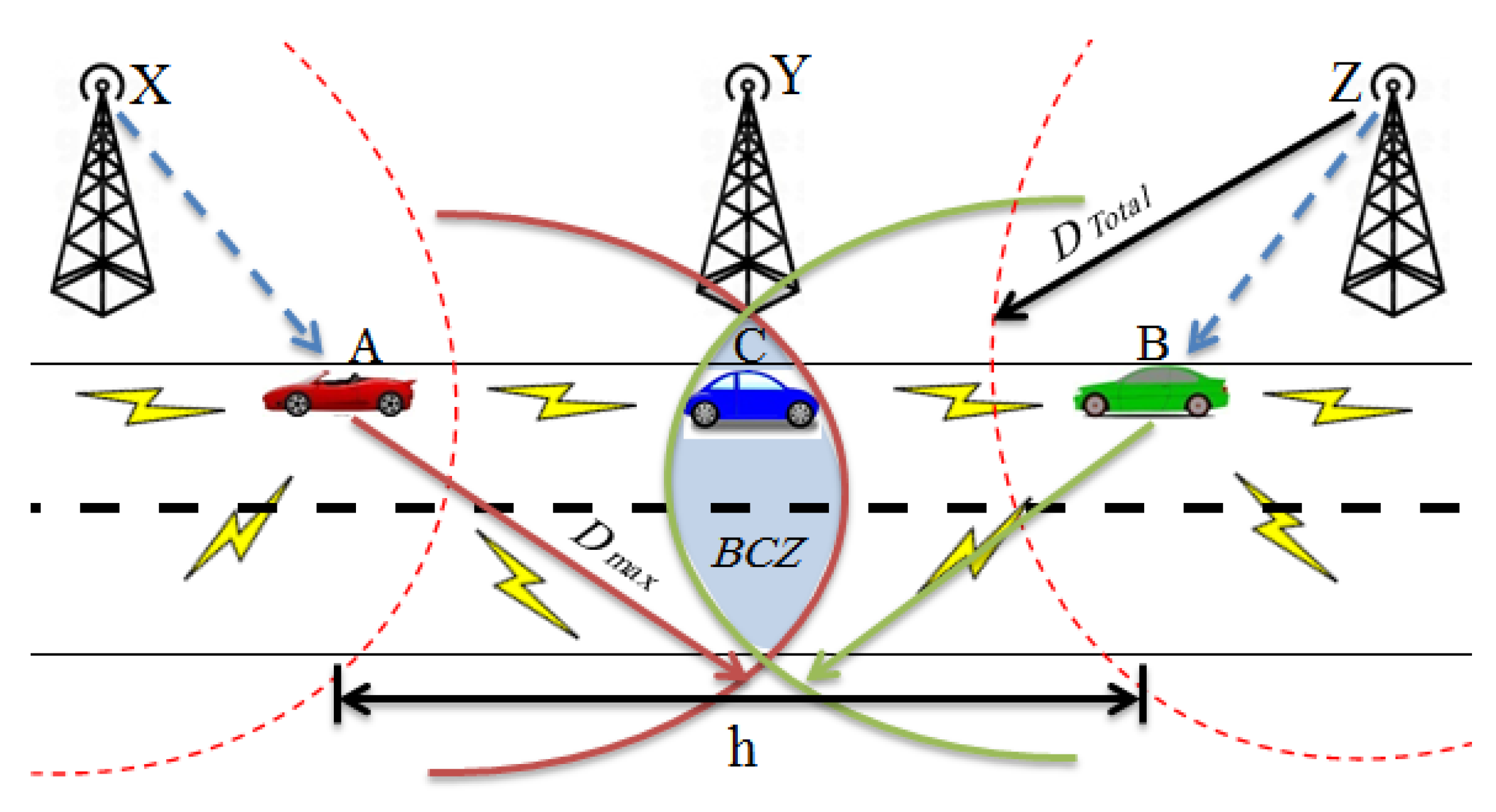
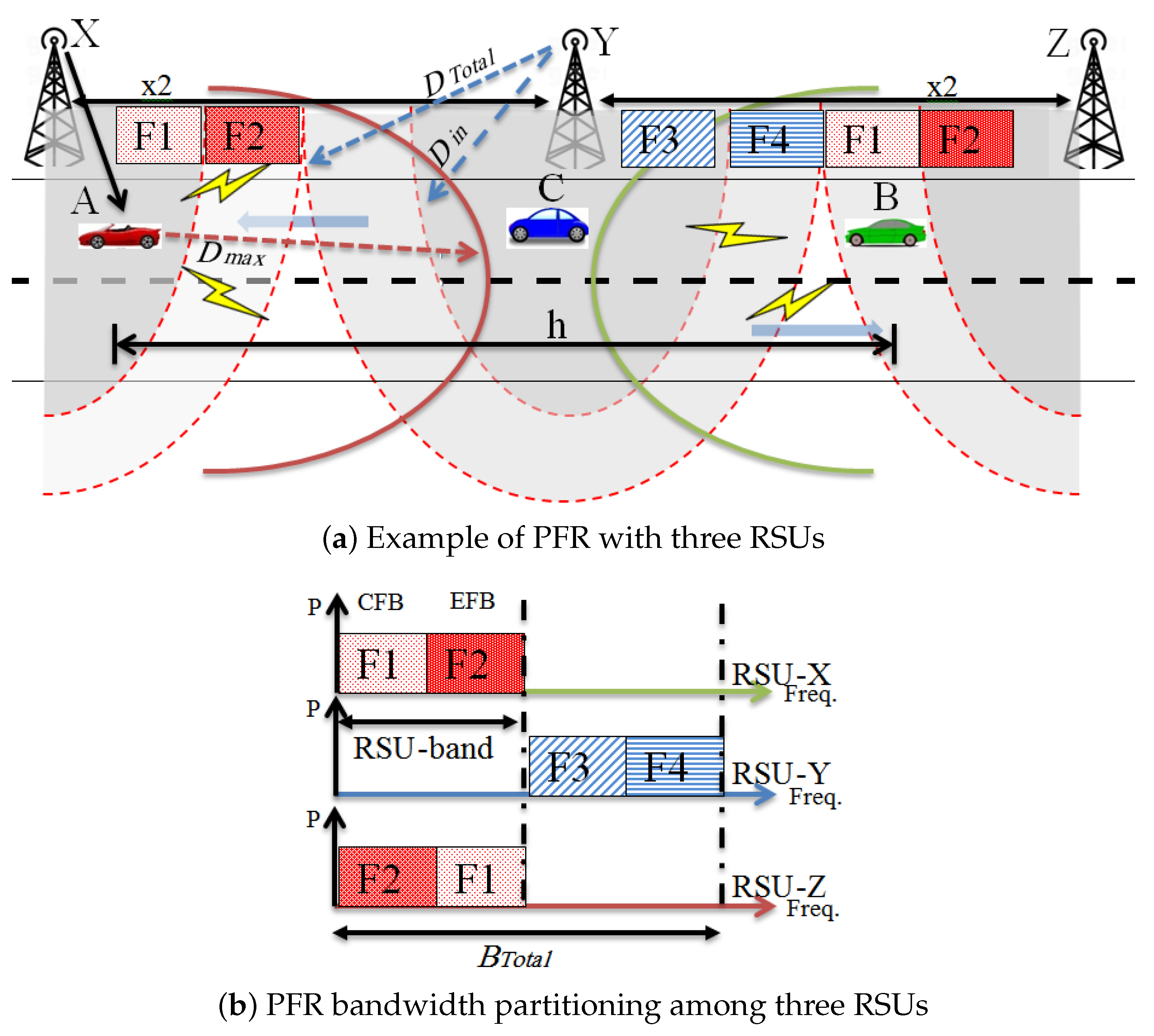

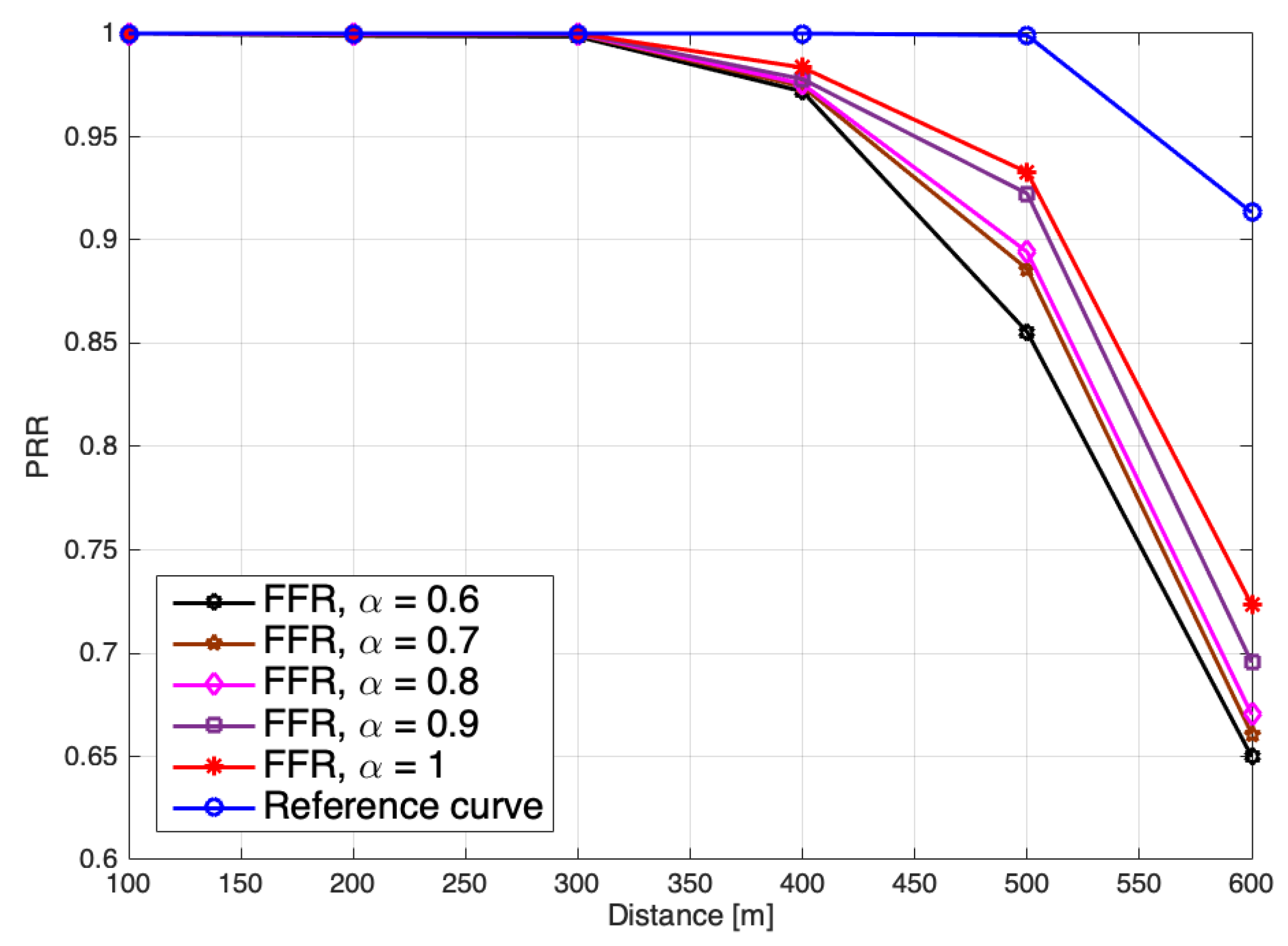
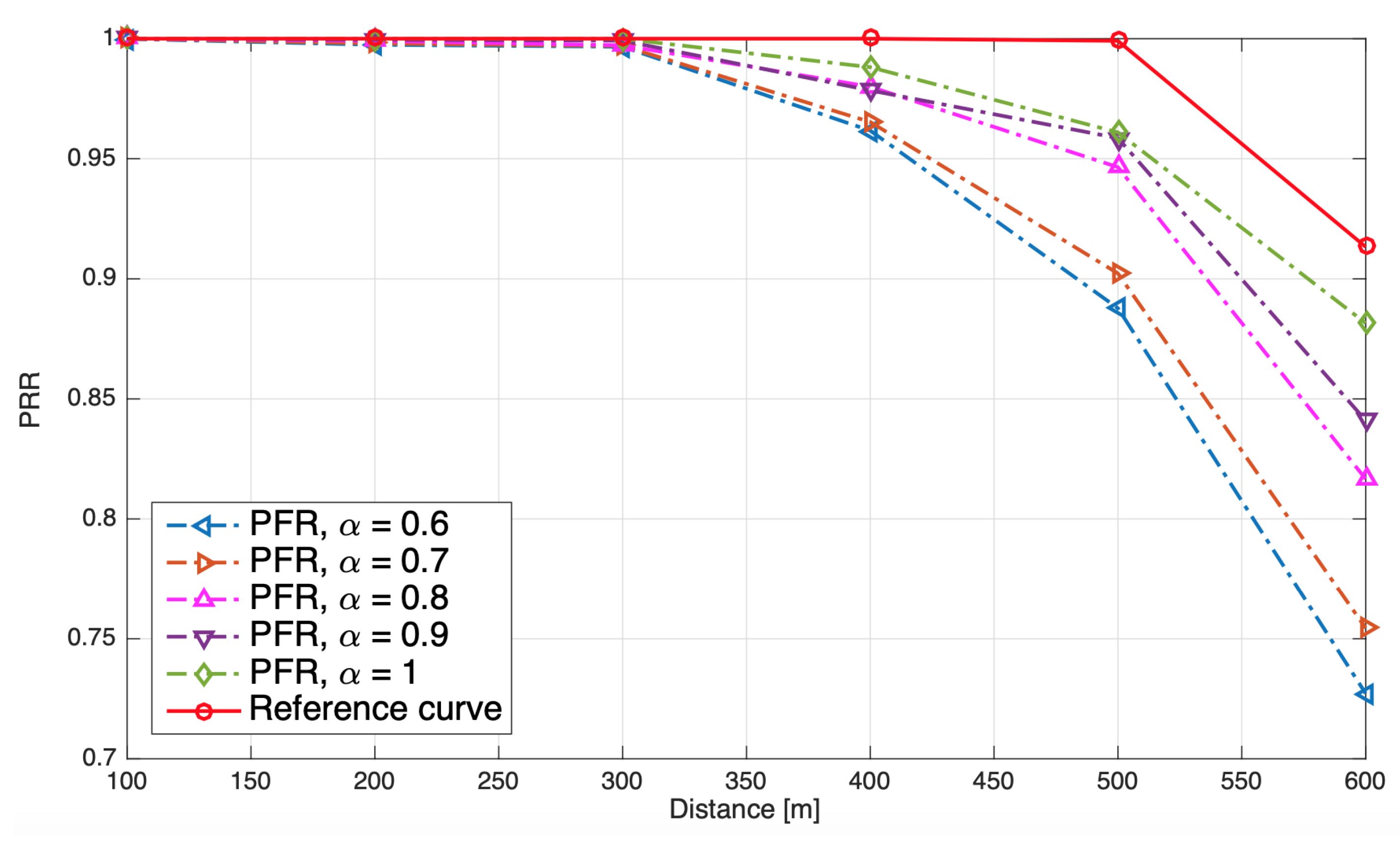
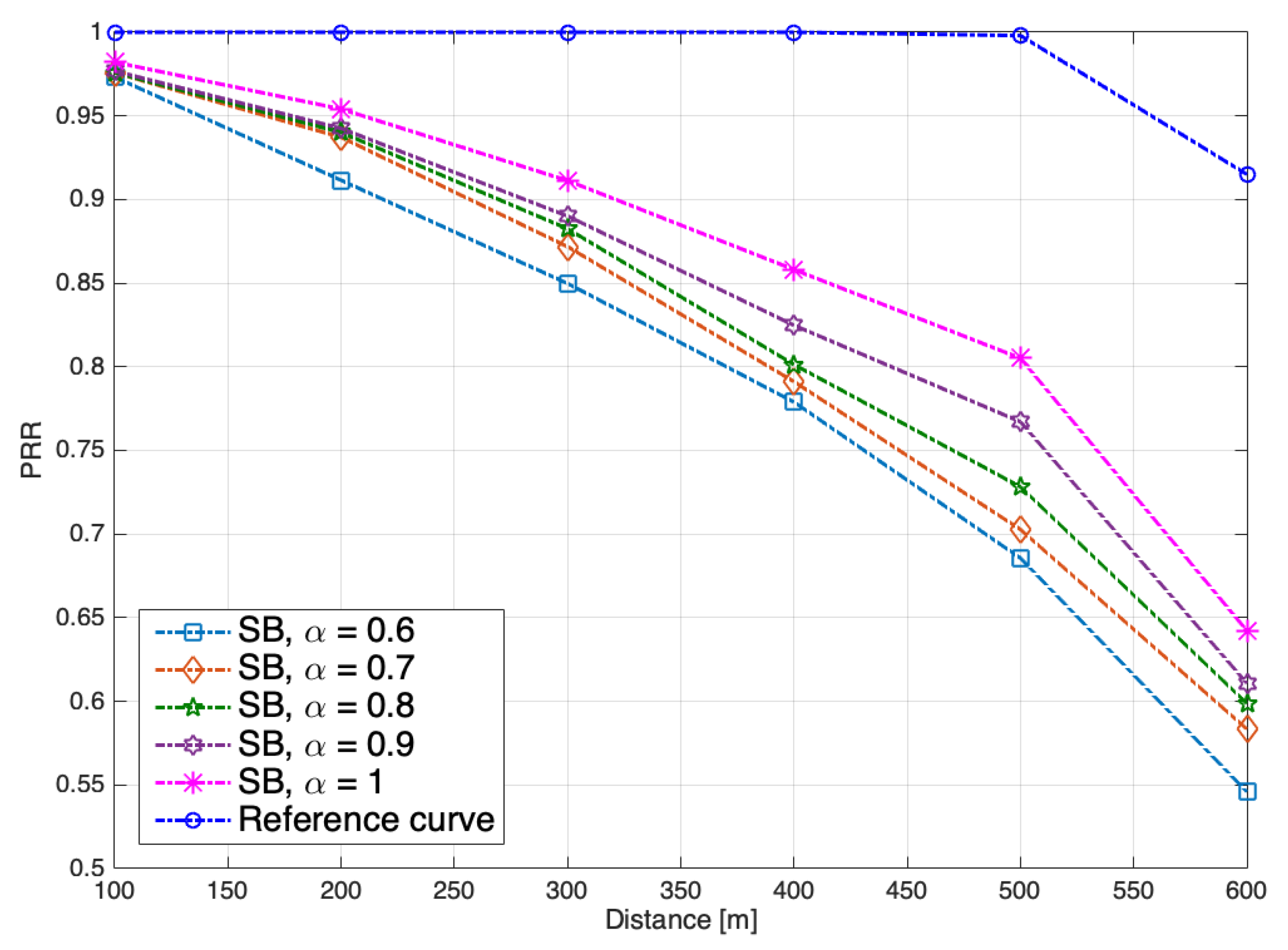
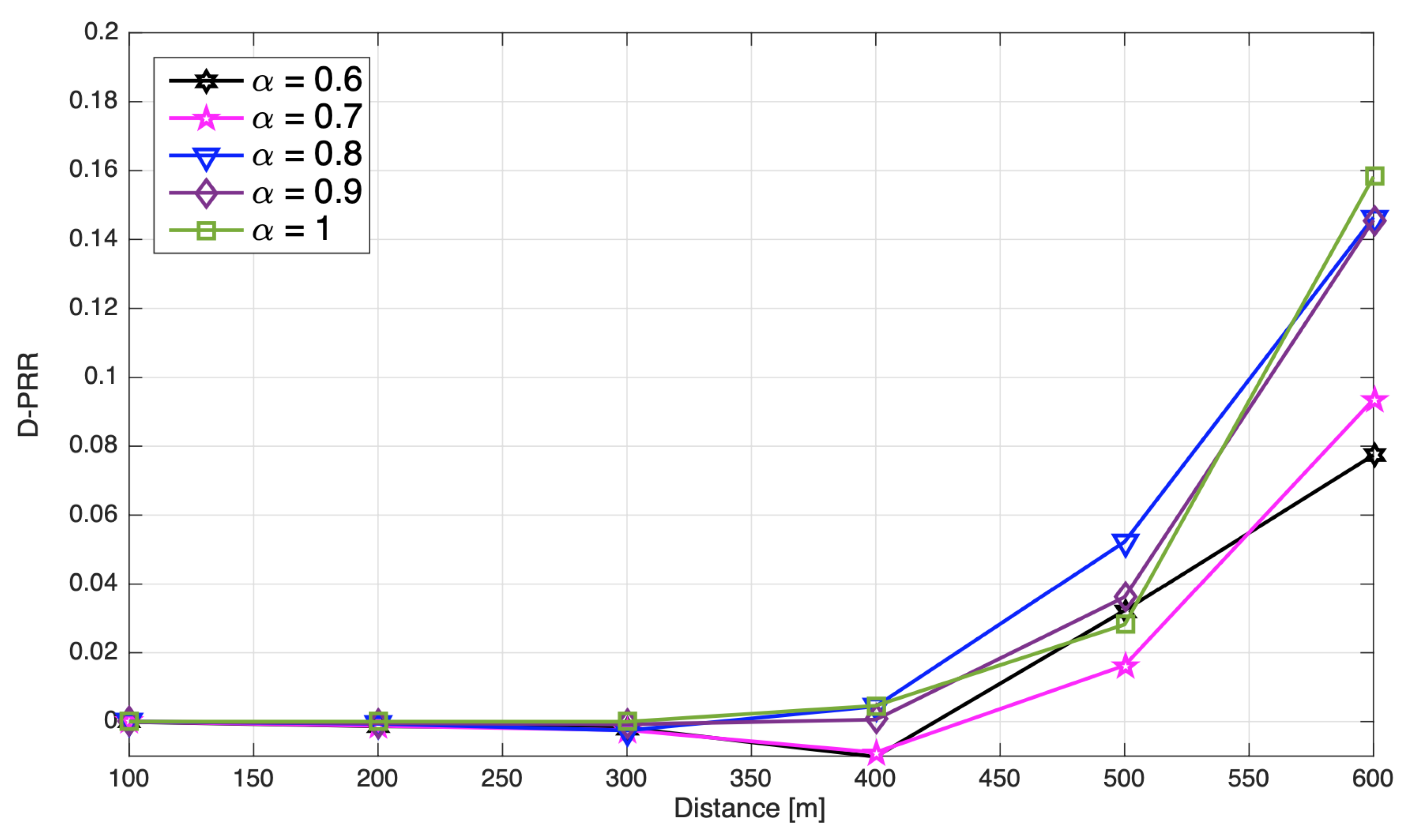

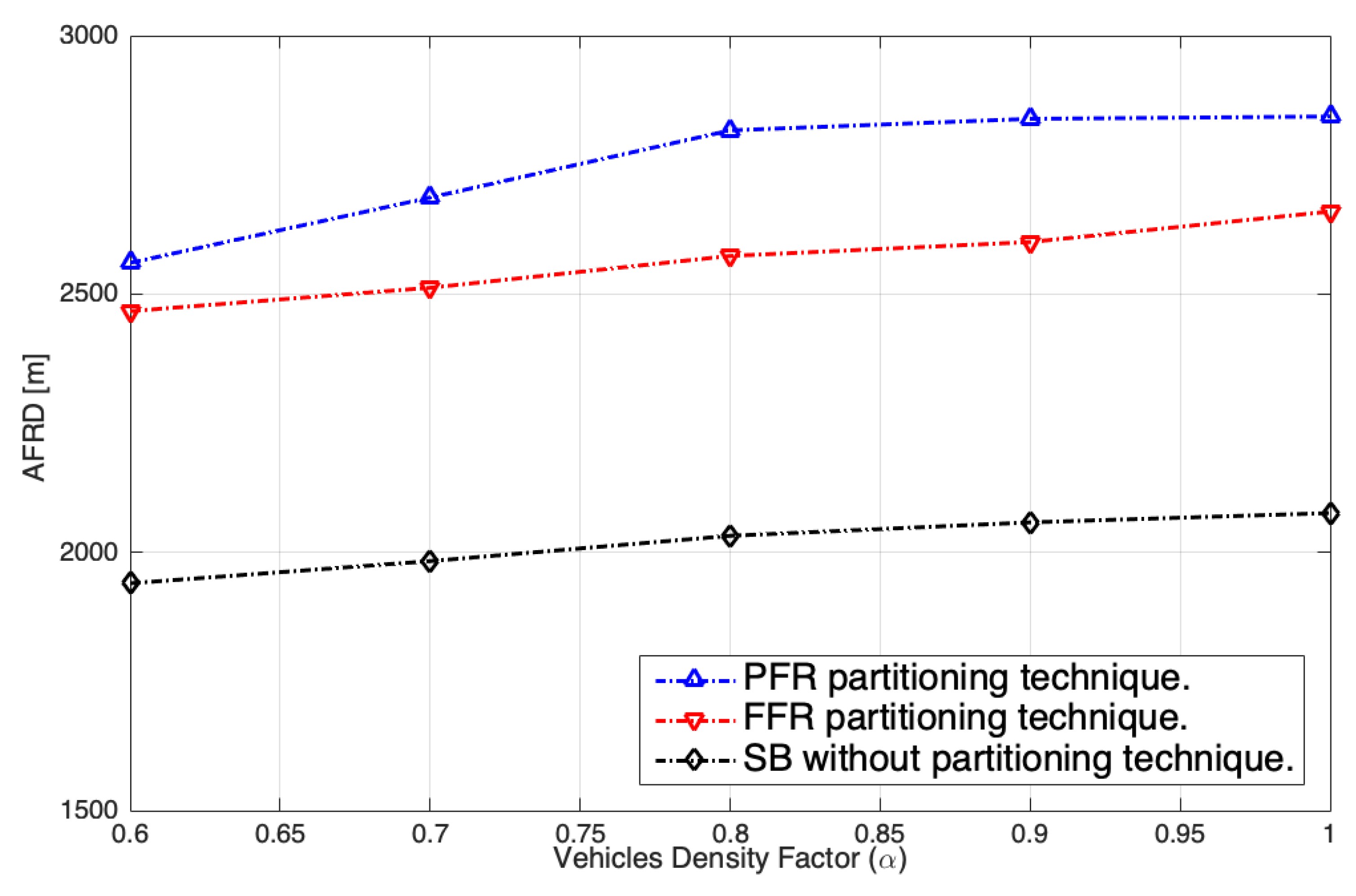
| Common Parameters and Settings | Values |
|---|---|
| Carrier frequency | 5.9 GHz |
| MCS | 8 |
| Broadcasting power by vehicles | 23 dBm |
| Bandwidth | 10 MHz |
| Shadowing | log-normal |
| Std. dev. | 3 dB |
| Road length × road width | 5000 m × 4 m |
| No. of lanes in each direction | 3 |
| Number of RSUs | 5 |
| Radius of RSU coverage | 500 m |
| Distance between RSUs | 1000 m |
| Radius of vehicle broadcasting coverage area | 600 m |
| Radius of inner RSU coverage | 250 m |
| Distance of RSUs to the highway | 3 m |
| Vehicles speed in each direction | 70, 100, 140 kmph |
| Antenna gain | 3 dBi |
| Path loss at 1 m | 37.02 dB |
| Loss exponent | 2.75 |
| Noise power over 10 MHz | −95 dBm |
| CAM interval | 100 ms |
| Packet size | 190 bytes |
| Simulation time | 5 s |
| Simulation time step | 100 ms |
| Vehicle density factor | [0.6–1] |
| Number of sub-channels in a sub-frame | 4 |
| Number of RBs in a sub-channel | 12 |
| 0.6 | 0.7 | 0.8 | 0.9 | 1 | |
|---|---|---|---|---|---|
| 1.32% | 1.02% | 0.80% | 0.78% | 0.72% |
| 0.6 | 0.7 | 0.8 | 0.9 | 1 | |
|---|---|---|---|---|---|
| 35.5% | 33.4% | 31.8% | 29.5% | 26.7% |
Publisher’s Note: MDPI stays neutral with regard to jurisdictional claims in published maps and institutional affiliations. |
© 2022 by the authors. Licensee MDPI, Basel, Switzerland. This article is an open access article distributed under the terms and conditions of the Creative Commons Attribution (CC BY) license (https://creativecommons.org/licenses/by/4.0/).
Share and Cite
Sabeeh, S.; Wesołowski, K.; Sroka, P. C-V2X Centralized Resource Allocation with Spectrum Re-Partitioning in Highway Scenario. Electronics 2022, 11, 279. https://doi.org/10.3390/electronics11020279
Sabeeh S, Wesołowski K, Sroka P. C-V2X Centralized Resource Allocation with Spectrum Re-Partitioning in Highway Scenario. Electronics. 2022; 11(2):279. https://doi.org/10.3390/electronics11020279
Chicago/Turabian StyleSabeeh, Saif, Krzysztof Wesołowski, and Paweł Sroka. 2022. "C-V2X Centralized Resource Allocation with Spectrum Re-Partitioning in Highway Scenario" Electronics 11, no. 2: 279. https://doi.org/10.3390/electronics11020279







